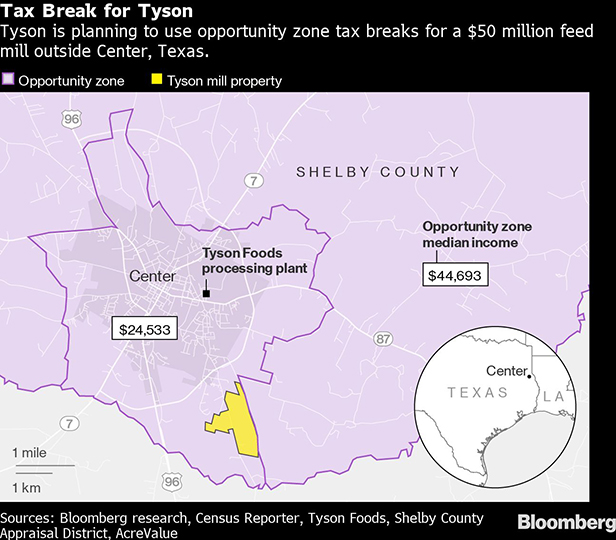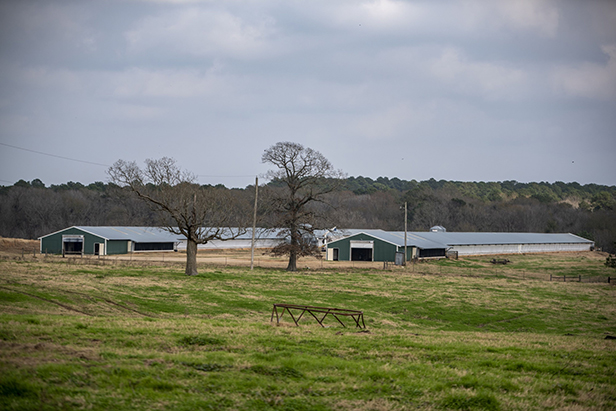There wouldn't be much of an economy in Center, Texas, without Tyson Foods Inc. The company has a sprawling chicken-processing plant in town and employs about 1,600 people in a city of just over 5,000 near the Louisiana border.
So, when Tyson signaled two years ago that it wanted to build a $50 million feed mill, Center's economic development director, Jim Gibson, was eager to find a location and suggest tax abatements.
Before long, Tyson keyed in on a new benefit: a tax break signed into law by President Donald Trump, aimed at luring new investments to thousands of low-income areas across the country dubbed "opportunity zones." Center and most of the surrounding area sat squarely in one.

"One of the people from Tyson said, 'I think we're going to make a run at doing these,'" Gibson recalled.
That was in private. Tyson—the country's biggest meat processor, with roughly $40 billion in annual revenue—announced its plans for the feed mill in February as it began to seek a separate local tax abatement. News reports and minutes from two county meetings where the project was addressed make no mention of opportunity zones.
The company wasn't required to say anything publicly about its plans to use the federal subsidy. But like scores of businesses and investors in recent months, Tyson left a faint paper trail. It beat a path to Delaware—where more than two-thirds of Fortune 500 companies have a legal home—to lay the groundwork for claiming one of the most controversial and generous benefits in Trump's 2017 tax overhaul.
Are Opportunity Zones Being Misused?
Once heralded as a novel way to help distressed parts of the U.S., opportunity zones are now being slammed as a government boondoggle. The perks are being used to juice investments in luxury developments from Florida to Oregon. And several reports have shown how politically connected investors influenced the selection of zones to benefit themselves.
Tyson's feed mill fits better with what lawmakers intended, but it highlights the lack of comprehensive data on who's claiming the benefits. Congress is now calling for changes to the legislation to boost transparency. In the meantime, supporters can point to anecdotal evidence that the benefits are spurring development in areas that really need it, and detractors can cite examples of waste.
An analysis of almost 400,000 Delaware Division of Corporations records since the start of 2018 provides a fresh glimpse into what's going on. After starting slowly last year—as states selected zones and the U.S. Treasury Department wrote regulations—the number of filings referencing opportunity zones accelerated dramatically. There were at least 356 entities containing acronyms or phrases associated with the tax breaks in June alone, and more than 1,800 through the end of September.

Real estate investors and developers, a group that gravitated to the tax breaks early, make up a big portion of the list. But the records show that the appeal is broader, extending to previously unreported efforts by Tyson, AT&T Inc. and NextEra Energy Inc. Billionaire hedge fund managers Steve Cohen and Bill Ackman have also made filings.
Tyson said it weighs a variety of factors when looking to expand, including the availability of workers and infrastructure. Government incentives often play a role, too, and were part of the equation for the new feed mill, said Derek Burleson, a spokesman for the Springdale, Arkansas-based company.
"Opportunity zones were created to help spur private development in economically challenged areas, and we believe this project will do just that," Burleson said in an email. "We see this as a significant investment in the community that will create new jobs with great benefits and make a positive impact on the local economy."
A spokeswoman for AT&T, which changed the names of two entities after an inquiry from Bloomberg News in July, scrubbing references to "opportunity zones," said the company is evaluating programs to invest in the areas. NextEra, the world's largest utility company by market value, declined to comment, as did spokesmen for Ackman and Cohen.
Opportunity for Better Transparency
The filings underscore the lack of transparency surrounding a federal subsidy that could cost billions of dollars, said Brett Theodos, a senior researcher at the Urban Institute who has studied opportunity zones. And it shows why the government should gather more information both about individual projects and the impact on communities as a whole.
"These are the exact types of investments that we will never learn about, absent more disclosure," said Theodos. "We should know how the government is spending our money, and it shouldn't fall to investigative journalists to figure this out."
That there's any record at all owes in part to jargon Congress used when drafting the law. Taxpayers who want to claim the benefits must hold their investments in a "qualified opportunity fund," a corporation or partnership that has most of its assets in "qualified opportunity zone" property.
Lawyers often use shorthand—such as QOF or QOZ—in naming the entities, even though it's not required, said Jessica Millett, head of the tax practice at Duval & Stachenfeld LLP in New York who has structured dozens of opportunity zone deals. "It just helps you remember what's what," she said, adding that Delaware was probably seeing a large share of the filings because of its longstanding reputation for being business-friendly.
Even so, the filings are just clues to what's going on, often giving little more than a name and date of formation. Many entities have names that are too generic or opaque to scrutinize, such as SM QOZB 3 LLC, created in September. Owners couldn't be identified in such cases.
Among those that can be identified are prominent developers or their projects. More than four dozen entities are tied to Starwood Capital Group, Brookfield Asset Management, or RXR Realty, which are raising hundreds of millions of dollars to build in the zones. Socially minded investors are also represented, including a $200 million collaborative effort between retired Tennessee Titans linebacker Derrick Morgan and Activated Capital, and another called Arctaris Impact, which has pledged to report publicly on its investments and pursue projects that benefit poor communities.
But so, too, are entities that likely stretch what lawmakers intended for the tax breaks. In July, someone used the Corporation Trust Co., a registered agent that handles many Delaware filings and can help obscure the identities of filers, to create a business called QOZ ART STORAGE QOF 2019, LLC.
Creating the companies or partnerships is no guarantee that a taxpayer will claim the incentives. Both Cohen and Ackman formed entities in June that were intended to allow them to invest in the zones, but neither has done so yet, according to people familiar with the filings who asked not to be identified discussing the hedge fund managers' plans.
Government Needs to Collect More Data
Just because investors and corporations aren't broadcasting their plans doesn't mean they're doing something untoward, said John Lettieri, CEO of the Economic Innovation Group, a Washington nonprofit that helped conceive of and promote opportunity zones. Companies often hold back information for competitive reasons, he added, and sometimes even philanthropic efforts are undertaken anonymously.
"On its face, it doesn't concern me," Lettieri said. "When you make a charitable contribution, you can choose to get your name plastered on a building or choose not to." Even so, he added, the government needs to be gathering more information about investments in the opportunity zones so that it can better evaluate whether the incentives are effective.
In October, the Treasury Department and the Internal Revenue Service released new forms that will require funds to say which opportunity zones they have property in and to declare the value of those assets. Treasury Secretary Steven Mnuchin called it an "important step toward a thorough evaluation" of the incentives. But researchers were quick to point out the shortcomings of the forms, which won't provide information such as the types of projects being funded or their precise locations. And because the disclosure is part of a tax return, the data may never be made public, said Samantha Jacoby, a senior tax law analyst at the Center on Budget and Policy Priorities.
Both Democrats and Republicans in Congress are advancing measures to gather more information. Among them is a bill introduced last month by Oregon Democratic Senator Ron Wyden that would bar certain kinds of investments, including stadiums, and require funds to file detailed public reports each year.
More transparency would allow the public to determine whether the incentives actually work as intended and discourage bad actors, Wyden said. "This is kind of Sunshine 101," he added. "What I keep coming back to is: Are the investment dollars largely benefiting those who are well-off in affluent communities? Or are they to support new projects in truly low-income communities?"
 A pair of chicken buildings are seen near a construction site outside of Center, Texas on Monday, Dec. 9, 2019. The site will be the home of a new feeding mill for chickens for Tyson Foods. Sergio Flores/Bloomberg
A pair of chicken buildings are seen near a construction site outside of Center, Texas on Monday, Dec. 9, 2019. The site will be the home of a new feeding mill for chickens for Tyson Foods. Sergio Flores/BloombergCenter is the kind of place that could use the money. The poverty rate hovers around 30 percent in the Census tract where it sits, making it a shoo-in for the opportunity zone designation. But investors haven't exactly been beating down the doors. "It's just not the happening spot in Texas right now," said Gibson, the economic development director.
The community lacks the skilled workforce that attracts businesses and real estate development to bigger cities, he said, adding that he couldn't think of an opportunity zone project in the area, other than the Tyson feed mill.
Construction of the facility—on a site outside of town and adjacent to a rail line—has already begun, according to Gibson. When it opens in 2021, it will churn out chicken feed for nearby poultry farms. About 40 people will work there, with an annual payroll of about $3 million.
In addition to the opportunity zone benefits, Tyson is getting a five-year break on its county taxes for the mill. But the company decided to forgo another program that would have allowed it to cut payments to the local school district, Gibson said. "It'll be really good for the schools," Gibson said. But, in the end, the number of jobs is pretty minimal, compared with the size of the investment, he added. "It's not one of those transformational game-changers."
—With assistance from David Ingold, Scott Moritz, Miles Weiss, and Dave Merrill.
© 2025 ALM Global, LLC, All Rights Reserved. Request academic re-use from www.copyright.com. All other uses, submit a request to [email protected]. For more information visit Asset & Logo Licensing.




